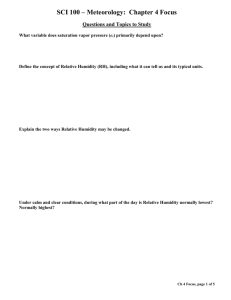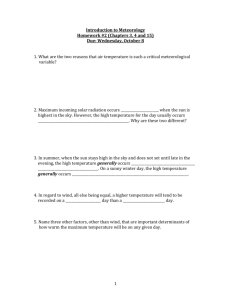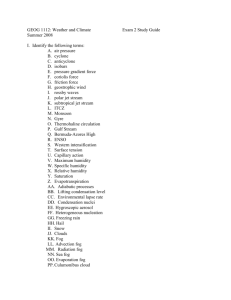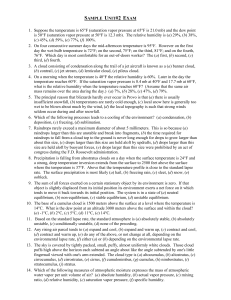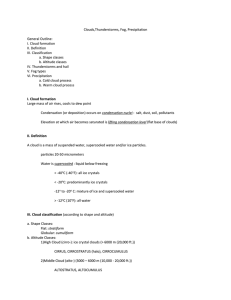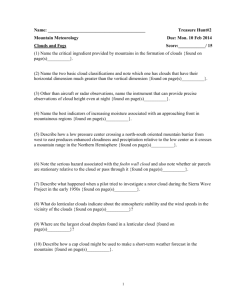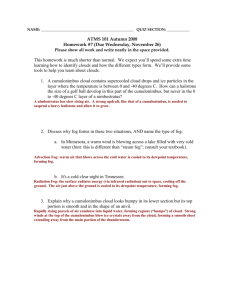doc file
advertisement
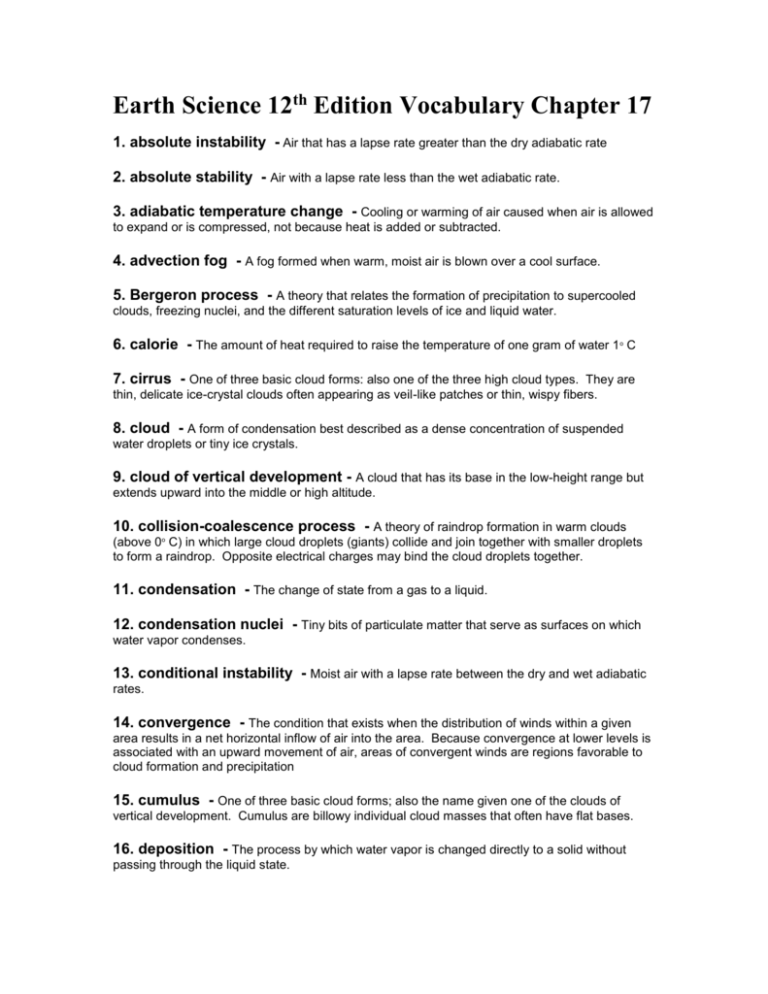
Earth Science 12th Edition Vocabulary Chapter 17 1. absolute instability - Air that has a lapse rate greater than the dry adiabatic rate 2. absolute stability - Air with a lapse rate less than the wet adiabatic rate. 3. adiabatic temperature change - Cooling or warming of air caused when air is allowed to expand or is compressed, not because heat is added or subtracted. 4. advection fog - A fog formed when warm, moist air is blown over a cool surface. 5. Bergeron process - A theory that relates the formation of precipitation to supercooled clouds, freezing nuclei, and the different saturation levels of ice and liquid water. 6. calorie - The amount of heat required to raise the temperature of one gram of water 1o C 7. cirrus - One of three basic cloud forms: also one of the three high cloud types. They are thin, delicate ice-crystal clouds often appearing as veil-like patches or thin, wispy fibers. 8. cloud - A form of condensation best described as a dense concentration of suspended water droplets or tiny ice crystals. 9. cloud of vertical development - A cloud that has its base in the low-height range but extends upward into the middle or high altitude. 10. collision-coalescence process - A theory of raindrop formation in warm clouds (above 0o C) in which large cloud droplets (giants) collide and join together with smaller droplets to form a raindrop. Opposite electrical charges may bind the cloud droplets together. 11. condensation - The change of state from a gas to a liquid. 12. condensation nuclei - Tiny bits of particulate matter that serve as surfaces on which water vapor condenses. 13. conditional instability - Moist air with a lapse rate between the dry and wet adiabatic rates. 14. convergence - The condition that exists when the distribution of winds within a given area results in a net horizontal inflow of air into the area. Because convergence at lower levels is associated with an upward movement of air, areas of convergent winds are regions favorable to cloud formation and precipitation 15. cumulus - One of three basic cloud forms; also the name given one of the clouds of vertical development. Cumulus are billowy individual cloud masses that often have flat bases. 16. deposition - The process by which water vapor is changed directly to a solid without passing through the liquid state. 17. dew-point temperature - The temperature to which air has to be cooled in order to reach saturation 18. dry adiabatic rate - The rate of adiabatic cooling or warming in unsaturated air. The rate of temperature change is 1o C per 100 meters. 19. evaporation - The process of converting a liquid to a gas. 20. fog - A cloud with its base at or very near the Earth's surface. 21. freezing nuclei - Solid particles that serve as cores for the formation of ice crystals. 22. frontal fog - Fog formed when rain evaporates as it falls through a layer of cool air. 23. front - The boundary between two adjoining air masses having contrasting characteristics. 24. frontal wedging - Lifting of air resulting cool air acts as a barrier over which warmer, lighter air will rise. 25. glaze - A coating of ice on objects formed when supercooled rain freezes on contact. 26. hail - Nearly spherical ice pellets having concentric layers and formed by the successive freezing of layers of water 27. high cloud - A cloud that normally has it base above 6000 meters; the base may be lower in winter and at high latitude locations. 28. humidity- A general term referring to water vapor in the air but not to liquid droplets of fog, cloud or rain. 29. hygrometer - An instrument designed to measure relative humidity. 30. hygroscopic nuclei - Condensation nuclei having a high affinity for water, such as salt particles. 31. latent heat - The energy absorbed or released during a change in state. 32. localized convective lifting - Unequal surface heating that causes localized pockets of air (thermals) to rise because of their buoyancy. 33. low cloud - A cloud that forms below a height of 2000 meters. 34. middle cloud - A cloud occupying the height range from 2000 to 6000 meters. 35. mixing ratio - The mass of water vapor in a unit mass of dry air; commonly expressed as grams of water vapor per kilogram of dry air. 36. orographic lifting - Mountains acting as barriers to the flow of air, forcing the air to ascend. The air cools adiabatically and clouds and precipitation may result. 37. parcel - An imaginary volume of air enclosed a a thin elastic cover. Typically it is considered to be a few hundred cubic meters in volume and is assumed to act independently of the surrounding air. 38. precipitation fog - Fog formed when rain evaporates as it falls through a layer of cool air. 39. psychrometer - A device consisting of two thermometers (wet bulb and dry bulb) that is rapidly whirled and, with the use of tables, yields the relative humidity and dew point. 40. radiation fog - Fog resulting from radiation heat loss by Earth. 41. rain - Drops of water that fall from a cloud and have a diameter of at least 0.5 millimeter (0.002 inch. 42. rain shadow desert - A dry area on the lee side of a mountain range. Many middlelatitude are of this type. 43. relative humidity - The ratio of the air's water-vapor content to its water-vapor capacity 44. rime - A thin coating ice on objects produced when supercooled fog droplets freeze on contact. 45. saturation - The maximum quantity of water vapor that the air can hold at any given temperature and pressure. 46. sleet - Frozen or semifrozen rain formed when raindrops freeze as they pass through a layer of cold air. 47. snow - A solid form of precipitation produced by sublimation of water vapor. 48. stable air - Air that resists vertical displacement. If it is lifted, adiabatic cooling will cause its temperature to be lower that the surrounding environment; if it is allowed, it will sink to is original position. 49. steam fog - Fog having the appearance of steam, produced by evaporation from a warm water surface into the cool air above. 50. stratus - One of the three basic cloud forms; also, the name given one of the flow clouds. They are sheets or layers that cover much or all of the sky. 51. sublimation - The conversion of a solid directly to a gas without passing through the liquid state. 52. supercooled - The condition of water droplets that remain in the liquid state at temperatures well below 0o C. 53. supersaturation - The condition of being more highly concentrated than is normally possible under given temperature and pressure conditions. When describing humidity, it refers to a relative humidity that is greater than 100 per cent. 54. unstable air - Air that does not resist vertical displacement. If it is lifted, its temperature will not cool as rapidly as the surrounding environment, so it will continue to rise on its own. 55. upslope fog - Fog created when air moves up a slope and cools adiabatically. 56. vapor pressure - That part of the total atmospheric pressure attributable to water-vapor content. 57. wet adiabatic rate - The rate of adiabatic temperature change in saturated air. The rate of temperature change is variable, but it is always less than the dry adiabatic rate.
